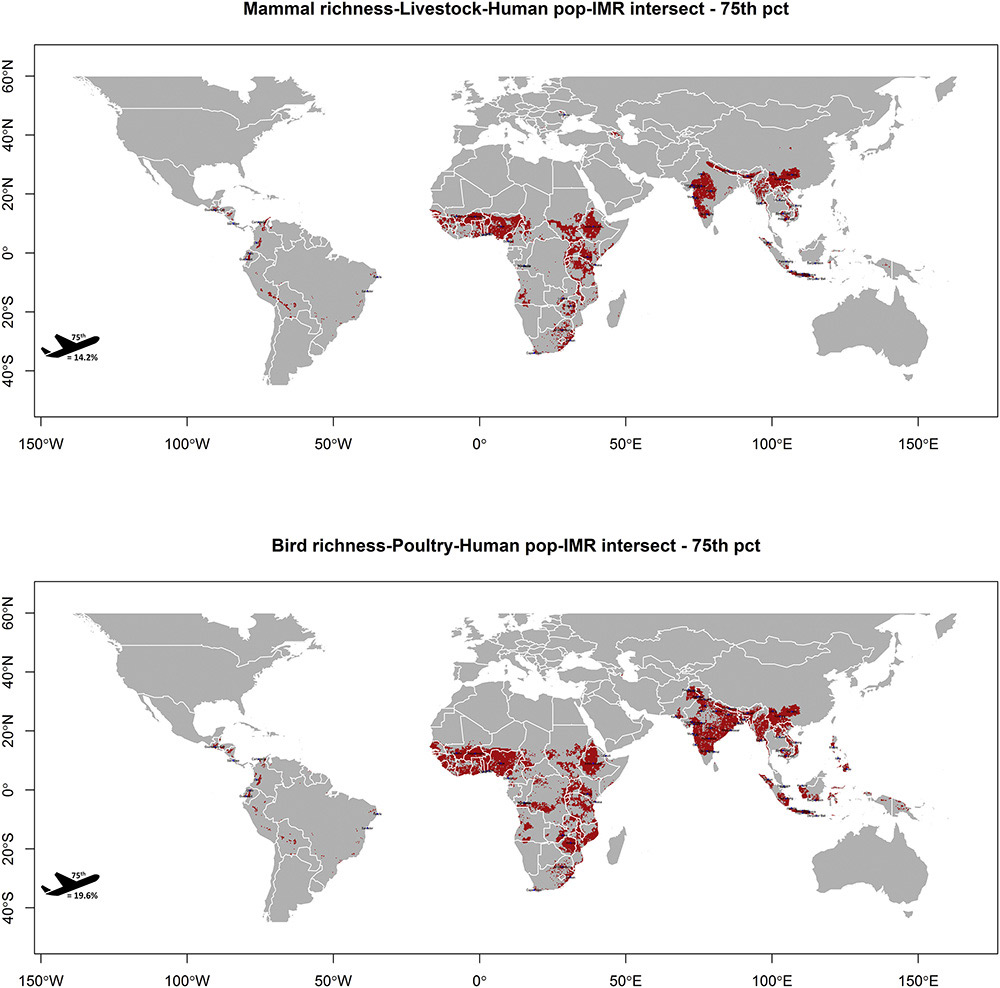专家警示,这些城市或将引爆下一轮疫情
孟买,雅加达。马尼拉。
科学家们表示,上述大都市都将面临一项全球性的风险:它们可能是下一波疫情的温床。
一个由悉尼大学(University of Sydney)的科学家领导、国际研究人员组成的团队用图绘的方式,标注出了一些特别值得关注的城市——它们可能孕育着下一波从动物传播到人类、再在全世界爆发的病毒所需的最成熟的条件。
研究人员跟踪到的风险来自三个因素:首先是确定在哪些城市中,繁忙的都市生活与家养动物以及丰富多样的野生生物之间可能会产生交集。这种在人类,驯养动物和野生生物之间的接触通常是由于植被遭到砍伐等自然环境的破坏而增加的。
这就增加了那些能够从动物传染给人类的疾病爆发的风险——例如某些病毒可以从哺乳动物或鸟类向人类传播。正如《财富》杂志在2020年4月的一篇文章中写道的那样,在新冠疫情爆发之前,病毒学家和其他科学家就已经发出警报称,我们所处的现代世界为这种病毒的爆发创造了理想的条件。

但是要造成全球性的大流行,悉尼大学的研究团队还探究了另外两个因素。
第二个因素是跟踪哪些大城市与世界各地都联系紧密——不只是通过国际机场和航空路线——从而使病毒可以迅速传播。第三个因素则是公共医疗基础设施的不足(这里是根据新生儿死亡率来衡量的),会增加其无法识别并报告正在传播的病毒的风险。
综合这些因素来看,研究人员发现,在与全球联系最紧密的城市中,有20%处于能够传播这类疾病的风险中。这些城市中还有14%至20%的医疗基础设施较差,大部分在南亚和东南亚,还有撒哈拉以南的非洲。风险最高的城市包括孟买、德里、雅加达、新加坡和昆明。

研究人员将风险分为三个等级:黄色、橙色和红色。红色表示风险等级最高,黄色表示最低。
考虑到医疗卫生水平,中低收入国家在表示高风险的“红色”区域中占很高的比例。但是悉尼大学的传染性流行病学专家、也是该研究的作者之一迈克尔•沃尔什表示,一些高收入城市(研究人员特别提到旧金山和澳大利亚的阿德莱德这两所城市)也存在一定风险,位于黄色区域。沃尔什说,这是因为富裕的城市会对当地的野生动植物产生极端影响。
他说,要应对这些风险,就需要采取一种整体的方法——着眼于野生生物的保护、畜牧业,还有改善人类医疗卫生系统以及对机场的监控,这将是一笔巨大的费用,但却是必要的。
“鉴于全球那么多地区都面临着难以承受的巨大风险,还有那么多和我们联系最紧密的城市也都同时处于高风险之中,这是一件值得引起我们共同关注的事情,并要立即采取措施。”(财富中文网)
编译:陈聪聪
孟买,雅加达。马尼拉。
科学家们表示,上述大都市都将面临一项全球性的风险:它们可能是下一波疫情的温床。
一个由悉尼大学(University of Sydney)的科学家领导、国际研究人员组成的团队用图绘的方式,标注出了一些特别值得关注的城市——它们可能孕育着下一波从动物传播到人类、再在全世界爆发的病毒所需的最成熟的条件。
研究人员跟踪到的风险来自三个因素:首先是确定在哪些城市中,繁忙的都市生活与家养动物以及丰富多样的野生生物之间可能会产生交集。这种在人类,驯养动物和野生生物之间的接触通常是由于植被遭到砍伐等自然环境的破坏而增加的。
这就增加了那些能够从动物传染给人类的疾病爆发的风险——例如某些病毒可以从哺乳动物或鸟类向人类传播。正如《财富》杂志在2020年4月的一篇文章中写道的那样,在新冠疫情爆发之前,病毒学家和其他科学家就已经发出警报称,我们所处的现代世界为这种病毒的爆发创造了理想的条件。
但是要造成全球性的大流行,悉尼大学的研究团队还探究了另外两个因素。
第二个因素是跟踪哪些大城市与世界各地都联系紧密——不只是通过国际机场和航空路线——从而使病毒可以迅速传播。第三个因素则是公共医疗基础设施的不足(这里是根据新生儿死亡率来衡量的),会增加其无法识别并报告正在传播的病毒的风险。
综合这些因素来看,研究人员发现,在与全球联系最紧密的城市中,有20%处于能够传播这类疾病的风险中。这些城市中还有14%至20%的医疗基础设施较差,大部分在南亚和东南亚,还有撒哈拉以南的非洲。风险最高的城市包括孟买、德里、雅加达、新加坡和昆明。
研究人员将风险分为三个等级:黄色、橙色和红色。红色表示风险等级最高,黄色表示最低。
考虑到医疗卫生水平,中低收入国家在表示高风险的“红色”区域中占很高的比例。但是悉尼大学的传染性流行病学专家、也是该研究的作者之一迈克尔•沃尔什表示,一些高收入城市(研究人员特别提到旧金山和澳大利亚的阿德莱德这两所城市)也存在一定风险,位于黄色区域。沃尔什说,这是因为富裕的城市会对当地的野生动植物产生极端影响。
他说,要应对这些风险,就需要采取一种整体的方法——着眼于野生生物的保护、畜牧业,还有改善人类医疗卫生系统以及对机场的监控,这将是一笔巨大的费用,但却是必要的。
“鉴于全球那么多地区都面临着难以承受的巨大风险,还有那么多和我们联系最紧密的城市也都同时处于高风险之中,这是一件值得引起我们共同关注的事情,并要立即采取措施。”(财富中文网)
编译:陈聪聪
Mumbai. Jakarta. Manila.
All of these mega-metropolises share a global risk, scientists say: they could be breeding grounds for the next pandemic.
A group of international researchers, led by scientists at the University of Sydney, have mapped out the cities that offer the ripest conditions for the incubation of viruses that could jump from animals to humans—and then spread around the world.
The researchers tracked the risks based on three factors: the first was identifying cities where intense urban life collides with both domesticated animals and rich biodiversity, raising interactions between humans, farmed animals, and wildlife, often due to disruption like deforestation.
This increases the risks of zoonotic disease outbreaks in which, for example, a virus makes the jump from a mammal or bird species to humans. Well before the arrival of COVID-19, virologists and other scientists have been sounding the alarm that our modern world creates ideal conditions for just such an outbreak, as Fortune wrote in April 2020.
But to create a global pandemic, the Sydney researchers researched an additional two factors.
The second is tracking which of those super cities are globally connected—not just through international airports and aviation routes—allowing the virus to be spread quickly. The third factor is an insufficient public healthcare infrastructure (measured, in this case, by rates of infant mortality), which increased the risk that a virus in circulation won't be identified and reported straight away.
Combining those factors, the researchers found that 20% of the world's most-connected cities are at risk of such disease spreads. Another 14-20% of those cities have poor health infrastructure, with the majority in South and Southeast Asia, and Sub-Saharan Africa. The cities with the highest risks including Mumbai, Delhi, Jakarta, Singapore, and Kunming, in China.
The researchers broke the risks down into three levels: a yellow, orange and red rating system with red the highest risk, yellow the lowest.
Low- and -middle income countries are highly represented in "red" due to the healthcare risks. But some high-income cities—the researchers cite San Francisco, and Adelaide, Australia as two—can be found in the yellow tier, said Michael Walsh, an infectious disease epidemiologist at the University of Sydney and one of the authors of the study, in a release. That's because of the extreme impact more affluent cities can have on local wildlife, Walsh said.
Addressing these risks would require a holistic approach, he said, one that looks at wildlife conservation and animal husbandry alongside human healthcare systems and monitoring and surveillance at airports—a huge cost, but a necessary one.
"Given the overwhelming risk absorbed by so many of the world's communities and the concurrent high-risk exposure of so many of our most connected cities, this is something that requires our collective prompt attention."













